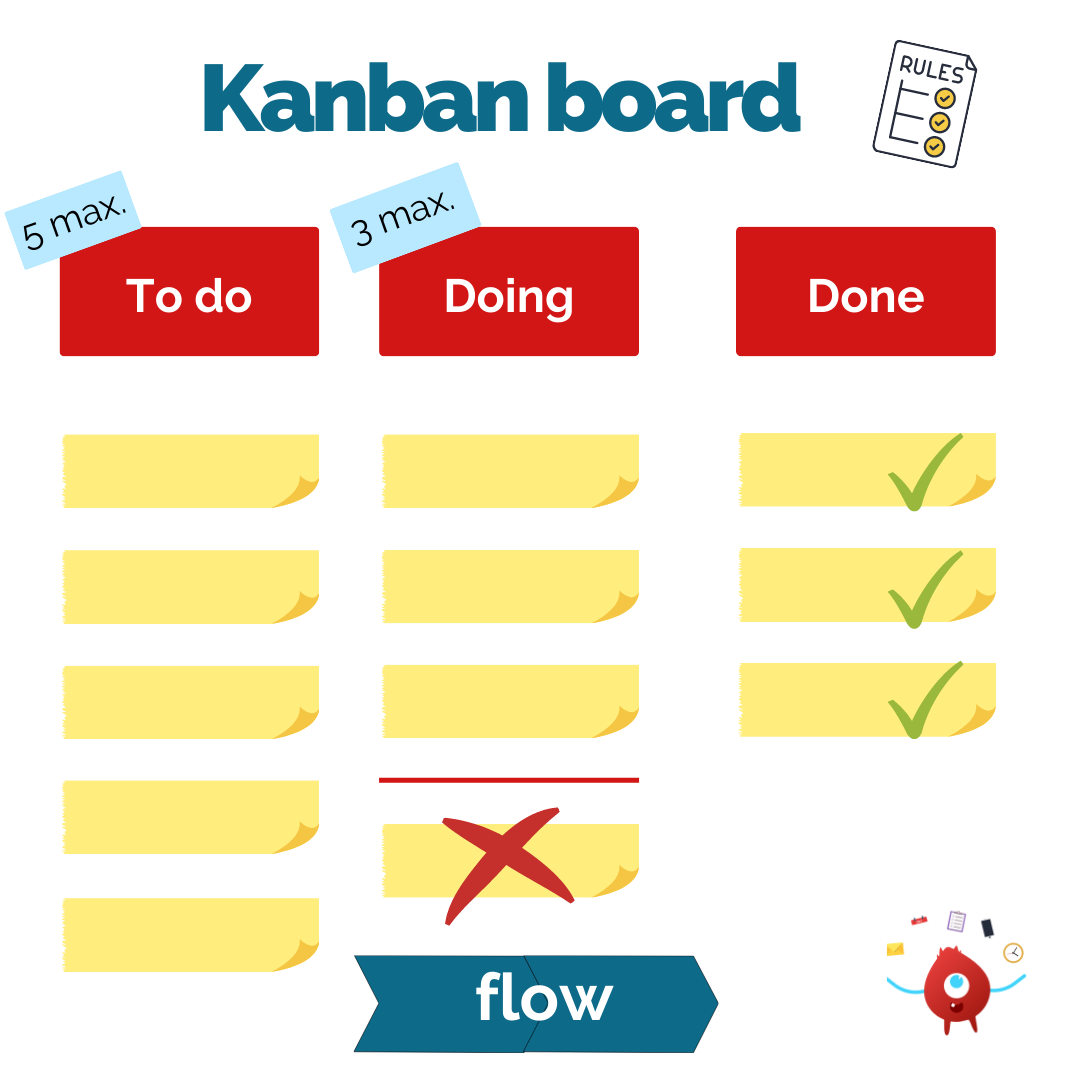2023-04-20 | Andrea Folger | 5 min read
The Kanban-Method - more than a Board
What do you think of when you hear the word Kanban?
Maybe you learned about the origin of the methodology during your studies, and now you think of Toyota and production?
Or maybe you have already come into contact with it in your daily work, or you have heard about it from other teams, and now you think of the board with all the tickets?
All this is correct. The Kanban method had its origin in production and is now very often used in software development.
Let's start from the beginning, what is Kanban anyway, and how did it come about?
The inventor of the Toyota production system, Taiichi Ohno, developed Kanban in 1947, and it is an implementation of the control method in production known as the pull principle.
He was inspired by the process of filling shelves in supermarkets. This is because supermarkets stock just enough products to satisfy consumer demand. The stock levels match the consumer habits of the customers. This avoids storing excess goods and occupying space for goods that are needed. It is simple and leads to great efficiency in inventory management.
So, Taiichi Ohno adopted this process in Toyota production. The cycle begins with the delivery of the required materials, including the kanban card, to the consuming location. As soon as the materials have been used up, the kanban card is returned to the responsible supplying point. Here, the production or procurement of the required materials in the specified quantity begins and as soon as this has been achieved, the materials are sent back to the consuming point, including the kanban card. You then have a self-controlling control loop without a central planning instance.
The technology used in this system has of course evolved in recent years, but it still forms the core of what is known as just-in-time production.

How is Kanban applied in software development today?
In principle, the Kanban method can be used in any industry due to its timeless core principles, which are explained in detail below. In the area of software development however, the agile method was particularly successful, because here no expenditures for the conversion are necessary like for example the change of physical processes. All that is needed is a board with cards, which can certainly be mapped virtually.
By the way, the word Kanban comes from Japanese and literally means 'visual signal.'
It is not without reason that Kanban is one of the most widespread agile management methods alongside Scrum. However, in order for the agile method to work properly, it takes a bit more than just a board and cards.
The Kanban board is of course in the center. It is there to visualize the tasks and to optimize the workflow of the team. A simple Kanban board consists of the three steps To do, Doing, and Done. Depending on the size, structure and goals of a team, the workflow can be extended or adapted accordingly. The Kanban cards map the tasks to be completed, and their progress is transparently mapped on the board. The Kanban cards provide information on the type of task, who is responsible for the task, how long it is estimated to take, etc.
But what makes Kanban a successful framework for agile working?
For this, we now look at the principles and practices of Kanban. If these are understood and used correctly alongside the Kanban board and its cards, you will quickly notice a significant improvement in your projects in terms of speed, clarity in the process, and satisfaction.
The following principles are important to keep in mind:
- Start with what you do now:
It's not about throwing all your processes out the window and starting from scratch. Quite the opposite. Continue exactly where you are right now. Identify existing value and address problems that hinder processes and outcomes. - Pursue incremental, evolutionary change.
Kanban recognizes that big changes are hard to introduce and often face headwinds. That's why we strive for incremental and evolutionary change with the method. - Respect the current processes, roles and responsibilities.
This principle also shows that Kanban does not change the basic framework of an organization overnight. Current processes, roles and responsibilities are respected and improvements are brought about in small steps. - Encourage acts of leadership at all levels.
Kanban recognizes the power of collaboration, but at the same time allows everyone to act and take leadership of a problem and address it.
Now that we understand what the principles behind Kanban are, let's look at the six practices that help us achieve great success with the Kanban method.
Make the work visible
To visualize the work, workflow and risks, the Kanban board is used. The work is represented by the cards on the board, the workflow is described by the columns from left to right, and the risks can often be seen in the detail of the cards, but often also visually, such as too many tickets in the "Doing" column.
Limit the work-in-progress (WIP).
Limiting the WIP means that there is never too much work and never too little, so that exactly the right number of cards can be processed by the available resources. This is achieved through the pull principle, where new work is drawn only when sufficient capacity is available. For this to work, the WIP limit must be set and adjusted.
Manage flow
Flow means the movement of work through the workflow from left to right. The project manager is responsible for ensuring a fast flow while keeping an eye on blockages and risks. The better the flow, the more efficiently the team works.
Make process rules explicit
In order for everyone to be looking in the same direction and for discussions to be rational and objective, guidelines are needed. These need to be documented and shared with everyone.
Introduce feedback loops
Feedback and continuous improvement are crucial in Kanban, as in all other agile frameworks. In the Kanban method, the meeting cadences you have set for yourselves are suitable for this. The only mandatory meeting is the Daily Kanban. Here it is a matter of taking a daily look at the flow and recognizing blockages and obstacles and clearing them out of the way. Other meetings, such as Refinements, Retrospective, Planning, or Review are scheduled as needed.
Improve collaboratively, evolve experimentally
In Kanban, collaboration and experimentation go hand in hand as long as there is clarity and consensus on how to approach work and problems.
So, start right where you are, pay attention to the principles, apply the practices, and tell me about your successes!
Looking for more expertise? Our consultants are happy to talk about agile topics with you and provide help on agile project management: Leave us a message.



